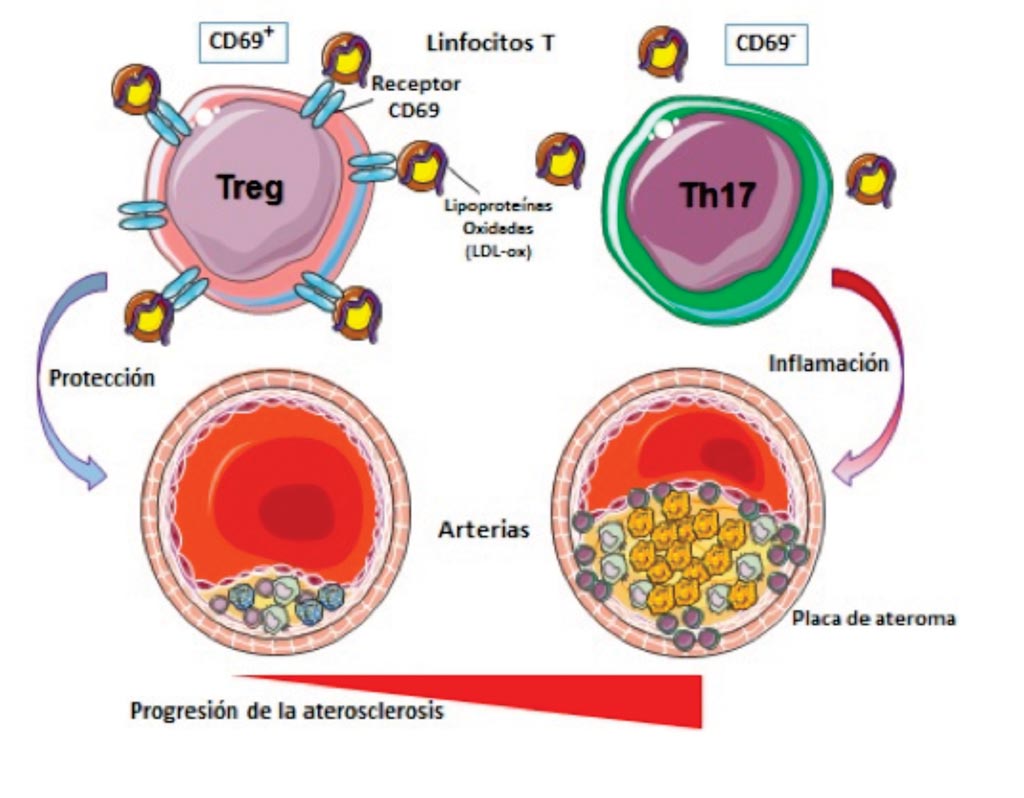CD69 Biomarker Expression Predicts Atherosclerosis Risk
By LabMedica International staff writers
Posted on 23 Jan 2019
Atherosclerosis is a disease characterized by the accumulation of lipid deposits in the artery wall, but the disease is usually not detected until after it has caused a clinical event such as a myocardial infarction or stroke.Posted on 23 Jan 2019
The origin of atherosclerosis and its progression to acute myocardial infarction and stroke involve an essential contribution from the inflammatory immune response. Because of the diminished quality of life experienced by affected individuals, treatment after symptoms appear is of limited benefit, and the long-term management of the disease is a major cost for health care systems.

Image: A diagram of the role of CD69 in atherosclerosis (Photo courtesy of the Spanish National Center for Cardiovascular Research).
Scientists at the Spanish National Center for Cardiovascular Research (Madrid, Spain) and their colleagues evaluated the association between the CD69 receptor, a regulator of Th17/regulatory T cell immunity, and atherosclerosis development in animal models and in patients with subclinical disease. Low-density lipoprotein receptor–deficient chimeric mice expressing or not expressing CD69 on either myeloid or lymphoid cells were subjected to a high fat diet. In vitro functional assays with human T cells were performed to decipher the mechanism of the observed phenotypes. Expression of CD69 and NR4A nuclear receptors was evaluated by reverse transcription–polymerase chain reaction in 305 male participants, 128 with extensive or 55 with focal subclinical atherosclerosis and 122 without disease.
To assess the immune response, the percentages of IL-17–eGFP+ or Foxp3-RFP+ cells in peripheral blood CD4+ T cells were monitored throughout the study by flow cytometry using a FACSCanto Flow Cytometer. Expression of NR4A receptors was also assessed in Jurkat T cells and human primary lymphocytes in the presence or not of Oxidized Low-Density Lipoprotein (oxLDL). When indicated, blocking anti-CD69 antibodies were also added. NR4A and CD69 mRNA expression was also determined in para-aortic lymph nodes and peripheral blood lymphocytes from mice.
The scientists reported that participants of the study with evidence of subclinical atherosclerosis displayed a significant CD69 and NR4A1 mRNA down regulation in peripheral blood leukocytes (PBLs) compared with participants without disease. The expression of CD69 remained associated with the risk of subclinical atherosclerosis after adjustment for traditional risk factors, the expression of NR4A1, the level of oxidized low-density lipoprotein, and the counts of different leucocyte subsets.
The authors concluded that CD69 depletion from the lymphoid compartment promotes a Th17/regulatory T cell imbalance and exacerbates the development of atherosclerosis. CD69 binding to oxidized low-density lipoprotein on T cells induces the expression of anti-inflammatory transcription factors. Data from a cohort with subclinical atherosclerosis indicated that CD69 expression in PBLs inversely correlates with the presence of disease. The expression of CD69 remained an independent predictor of subclinical atherosclerosis after adjustment for traditional risk factors. The study was published in the January 2019, issue of the journal Circulation.
Related Links:
Spanish National Center for Cardiovascular Research














